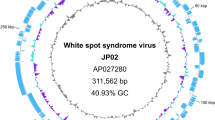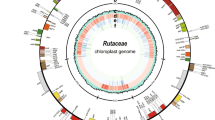Abstract
The full-length sequences of 34 Iranian cauliflower mosaic virus (CaMV) isolates were compared with others from public nucleotide sequence databases to provide a comprehensive overview of the genetic variability and patterns of genetic exchange in CaMV isolates from Iran. Based on the severity of symptoms and their ability to infect Brassica oleracea var. capitata, Iranian CaMV isolates were grouped into two distinct biotypes: latent/mild mottle (LI/MMo) and severe (S) infection. Recombination breakpoints were detected between the large intergenic region (LIR) and open reading frame (ORF) V (event 2); between ORF VII and ORF II (event 3), between ORF I and ORF III (event 4), and within ORF VI (event 1). Phylogenetic analysis indicated that Iranian CaMV isolates clustered into two subgroups belonging to group I (GI) that were distinct from North American and European isolates from group II (GII). Northeast Iranian isolates (subgroup B) and CaMV isolates from subgroup A closely corresponded to the S and LI/MMo biological groups, respectively. Genome-wide pairwise identity analysis of the CaMV isolates revealed three regions of pairwise identity representation: 92–94 % for GII and 94–96 % and 98–100 % for subgroups A and B. The within-population diversity was lower than the between-population diversity, suggesting the contribution of a founder effect on diversification of CaMV isolates. Amino acid sequences were conserved, with ω values ranging from 0.074 to 0.717 in different proteins. Thirteen amino acids in the deduced proteins of ORFs I, II, III, VI and VII were under positive selection (ω > 1), whereas purifying selection applied to the proteins encoded by ORFs IV and V. This study suggests that variation in the CaMV population can be explained by host-range differentiation and selection pressure. Moreover, recombination analysis revealed that a genomic exchange is responsible for the emergence of CaMV strains, providing valuable new information for understanding the diversity and evolution of caulimoviruses.



Similar content being viewed by others
References
Al-Kaff NS, Covey SN (1995) Biological diversity of Cauliflower mosaic virus isolates expressed in two Brassica species. Plant Path 44:516–526
Anisimova M, Nielsen R, Yang Z (2003) Effect of recombination on the accuracy of the likelihood methods for detecting positive selection at amino acid sites. Genetics 164:1229–1236
Blevins T, Rajeswaran R, Aregger M, Borah BK (2011) Massive production of small RNAs from anon-coding region of Cauliflower mosaic virus in plant defense and viral counter-defense. Nucl Acids Res 39:1–12
Cavatorta JR, Savage AE, Yeam I, Gray SM, Jahn MM (2008) Positive Darwinian selection at single amino acid sites conferring plant virus resistance. J Mol Evol 67:551–559
Chenault KD, Melcher U (1993) The complete nucleotide sequence of Cauliflower mosaic virus isolate BBC. Gene 123:255–257
Chenault KD, Melcher U (1994) Patterns of nucleotide sequence variation among Cauliflower mosaic virus isolates. Biochemistry 76:3–8
Chenault KD, Melcher U (1994) Phylogenetic relationships reveal recombination among isolates of Cauliflower mosaic virus. J Mol Evol 39:496–505
Clark MF, Adams AN (1977) Characteristics of the microplate method of the enzyme-linked immunosorbent assay for the detection of plant viruses. J Gen Virol 34:474–483
Covey SN (1991) Pathogenesis of a plant pararetrovirus: CaMV. Semi Virol 2:151–159
De Tapia M, Himmelbach A, Hohn T (1993) Molecular dissection of the Cauliflower mosaic virus translation transactivator. EMBO J 12:3305–3314
Elena SF, Sanjuán R (2007) Virus evolution, insights from an experimental approach. Annu Rev Ecol Evol Sys 38:27–52
El-Shami M, Pontier D, Lahmy S, Braun L et al (2007) Reiterated WG/GW motifs form functionally and evolutionarily conserved ARGONAUTE-binding platforms in RNAi-related components. Genes Dev 21:2539–2544
Farzadfar SH, Ahoonmanesh A, Mosahebi GH, Ohshima K, Koohi-Habibi M, Pourrahim R, Golnaraghi AR (2007) Partial biological and molecular characterization of Cauliflower mosaic virus isolates in Iran. Plant Path J 6:291–298
Froissart R, Roze D, Uzest M, Galibert L, Blanc S (2005) Recombination every day: abundant recombination in a virus during a single multi-cellular host infection. PLoS Biol 3:389–395
Garcia-Arenal F, Fraile A, Malpica JM (2003) Variation and evolution of plant virus populations. Int Microbiol 6:225–232
Garcia-Arenal F, Palukaitis F (2008) Cucumber mosaic virus. In: Mahy BWJ, van Regenmortel MHV (eds) Encyclopedia of VIROLOGY, 3rd edn. Academic Press is an iprint of Elsevier, pp 614–619
Geering ADW, Hull R (2012) Family Caulimoviridae. In: King AMQ, Adams MJ, Carestens EB, Lefkowitz EJ (eds) Virus taxonomy classification and nomenclature of viruses ninth report of the international committee on taxonomy of viruses. San Diego, Elsevier pp 424–443
Gibbs MJ, Armstrong JS, Gibbs AJ (2000) Sister-scanning: a Monte Carlo procedure for assessing signals in recombinant sequences. Bioinformatics 16:573–582 (http://www.anu.edu.au/BoZo/software/)
Haas M, Burea M, Gelderich A, Yot P, Keller M (2002) Cauliflower mosaic virus: Still in the news. Mol Plant Pathol 3:419–429
Hall TA (1999) BIOEDIT: a user-friendly biological sequence alignment editor and analysis program for Windows 95/98/NT. Nucl Acids Sym Ser 41:95–98
Hohn T, Hohn B, Pfeiffer P (1985) Reverse transcription in CaMV. Trends Biochem Sci 10:205–209
Kimura M (1980) A simple method for estimating evolutionary rates of base substitutions through comparative studies of nucleotide sequences. J Mol Evol 16:111–120
Larkin MA, Blackshields G, Brown NP, Chenna R, McGettigan PA, McWilliam H, Valentin F, Wallace IM, Wilm A, Lopez R, Thompson JD, Gibson TJ, Higghins DG (2007) Clustal W and Clustal X version 2.0. Bioinformatics 23:2947–2948
Leh V, Jacquot E, Geldreich A, Haas M, Blanc S, Keller M, Yot P (2001) Interaction between the open reading frame III product and the coat protein is required for transmission of Cauliflower mosaic virus by aphid. J Virol 75:100–106
Love AJ, Laird J, Holt J, Hamilton AJ, Sadanandom A, Milner JJ (2007) Cauliflower mosaic virus protein P6 is a suppressor of RNA silencing. J Gen Virol 88:3439–3444
Lung MCY, Pirone TP (1972) Datura stramonium, a local host for certain isolates of Cauliflower mosaic virus. Phytopathology 62:1473–1474
Martin DP, Lemey P, Lott M, Moulton V, Posada D (2010) RDP3: a flexible and fast computer program for analyzing recombination. Bioinformatics 26:2462–2463
Monsion B, Froissart R, Michalakis Y, Blanc S (2008) Large bottleneck size in Cauliflower mosaic virus populations during host plant colonization. PLoS Path 4:1–7
Ohshima K, Yamaguchi Y, Hirota R et al (2002) Molecular evolution of Turnip mosaic virus: evidence of host adaptation, genetic recombination and geographical spread. J Gen Virol 83:1511–1521
Pourrahim R, Golnaraghi AR, Farzadfar S, Ohshima K (2012) Partial biological and molecular characterization of Tomato yellow fruit ring virus isolates from potato. Plant Path J 28:390–400
Rozas J, Sanchez-DeI, Barrio JC, Messeguer X, Rozas R (2003) dnasp, DNA polymorphism analyses by the coalescent and other methods. Bioinformatics 19:2496–2497
Schoelz JE, Shepherd RJ, Richins RD (1986) Properties of an unusual strain of Cauliflower mosaic virus. Phytopathology 76:451–454
Scholthof KG, Adkins S, Czosnek H, Palukaitis P, Jacquot E (2011) Top 10 plant viruses in molecular plant pathology. Mol Plant Pathol 12:938–954
Tamura K, Dudley J, Nei M, Kumar S (2007) MEGA4: Molecular Evolutionary Genetics Analysis (MEGA) software version 4.0. Mol Biol Evol 24:1596–1599
Tomitaka Y, Ohshima K (2006) A phylogeographical study of the Turnip mosaic virus population in East Asia reveals an ‘emergent’ lineage in Japan. Mol Ecol 5:4437–4457
Vaden VR, Melcher U (1990) Recombination sites in Cauliflower mosaic virus DNAs: Implications for mechanisms of recombination. Virology 177:717–762
Weiller GF (1998) Phylogenetic profiles: a graphical method for detecting genetic recombinations in homologous sequences. Mol Biol Evol 15:326–335
Wintermantel WM, Anderson EJ, Schoelz JE (1993) Identification of domains within gene VI of Cauliflower mosaic virus that influence systemic infection of Nicotiana bigelovii in a light-dependent manner. Virology 196:789–798
Wong WSW, Yang Z, Goldman N, Nielsen R (2004) Accuracy and power of statistical methods for detecting adaptive evolution in protein coding sequences and for identifying positively selected sites. Genetics 168:1041–1051
Wright S (1978) Evolution and the Genetics of Populations. Variability within and among Natural Populations. University of Chikago Press, Chikago
Xiong Y, Eickbush TH (1990) Origin and evolution of retroelements based upon their reverse transcriptase sequences. EMBO J 9:3353–3362
Yang Z (2007) PAML4: phylogenetic analysis by maximum likelihood. Mol Biol Evol 24:1586–1591
Yang Z, Nielsen R, Goldman N, Pedersen AK (2000) Codon substitution models for heterogeneous selection pressure at amino acid sites. Genetics 155:431–449
Yang Z, Wong WSW, Nielsen R (2005) Bayes empirical Bayes inference of amino acid sites under positive selection. Mol Biol Evol 22:1107–1118
Author information
Authors and Affiliations
Corresponding author
Electronic supplementary material
Below is the link to the electronic supplementary material.
705_2013_1910_MOESM1_ESM.jpg
Supplementary Fig. S1. Symptoms induced by cauliflower mosaic virus isolates IRNCCK3 (a and b) and IRNRKh22 (c and d) belonging to the phylogenetic groups GI and GII, respectively, on the indicator cabbage plants B. oleracea var. capitata alba (a and c) and B. oleracea var. capitata cv. Ryozan 2-go (b and d). Healthy plant of B. oleracea var. capitata alba (h). (JPEG 104 kb)
Rights and permissions
About this article
Cite this article
Farzadfar, S., Pourrahim, R. & Ebrahimi, H. A phylogeographical study of the cauliflower mosaic virus population in mid-Eurasia Iran using complete genome analysis. Arch Virol 159, 1329–1340 (2014). https://doi.org/10.1007/s00705-013-1910-5
Received:
Accepted:
Published:
Issue Date:
DOI: https://doi.org/10.1007/s00705-013-1910-5




